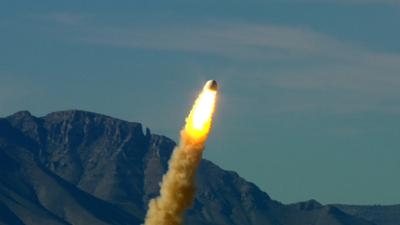Fri, Sep 09, 2016
Flight Planned For Early October
Jeff Bezos says the next flight of New Shepard is going to be dramatic, no matter how it ends.

Like Mercury, Apollo, and Soyuz, Blue Origin's New Shepard has an escape system that can quickly propel the crew capsule to safety if a problem is detected with the booster. But according to Bezos, the escape system is configured differently from those earlier designs. They mounted the escape motor on a tower above the capsule – a “tractor” configuration – the escape motor would pull the capsule away from a failing booster. But because a capsule cannot reenter Earth’s atmosphere or deploy parachutes with a tower on top, the tower, along with the escape motor, must be jettisoned on every flight – even the nominal flights. Expending an escape motor on every flight drives up costs significantly. Further, the jettison operation is itself safety critical. Failure to jettison the tower is catastrophic.
Bezos says the New Shepard escape motor pushes rather than pulls and is mounted underneath the capsule rather than on a tower. There is no jettison operation. On a nominal mission, the escape motor is not expended and can be flown again and again. We’ve already tested our pusher escape system (see image above), including many ground tests and a successful pad escape test, but this upcoming flight will be our toughest test yet. We’ll intentionally trigger an escape in flight and at the most stressing condition: maximum dynamic pressure through transonic velocities.
Capsule in-flight escape testing was last done during the Apollo program. From 1964-1966, in-flight escape tests were performed with Apollo simulator capsules using an expendable booster called the Little Joe II. We’ll be doing our in-flight escape test with the same reusable New Shepard booster that we’ve already flown four times. About 45 seconds after liftoff at about 16,000 feet, we’ll intentionally command escape. Redundant separation systems will sever the crew capsule from the booster at the same time we ignite the escape motor. The escape motor will vector thrust to steer the capsule to the side, out of the booster’s path. The high acceleration portion of the escape lasts less than two seconds, but by then the capsule will be hundreds of feet away and diverging quickly. It will traverse twice through transonic velocities – the most difficult control region – during the acceleration burn and subsequent deceleration. The capsule will then coast, stabilized by
reaction control thrusters, until it starts descending. Its three drogue parachutes will deploy near the top of its flight path, followed shortly thereafter by main parachutes.
What of the booster? It’s the first ever rocket booster to fly above the Karman line into space and then land vertically upon the Earth. And it’s done so multiple times. Bezos said he would really like to retire it after this test and put it in a museum. "Sadly, that’s not likely. This test will probably destroy the booster. The booster was never designed to survive an in-flight escape. The capsule escape motor will slam the booster with 70,000 pounds of off-axis force delivered by searing hot exhaust. The aerodynamic shape of the vehicle quickly changes from leading with the capsule to leading with the ring fin, and this all happens at maximum dynamic pressure.
"Nevertheless, the booster is very robust and our Monte Carlo simulations show there’s some chance we can fly through these disturbances and recover the booster," Bezos said. "If the booster does manage to survive this flight – its fifth – we will in fact reward it for its service with a retirement party and put it in a museum. In the more likely event that we end up sacrificing the booster in service of this test, it will still have most of its propellant on board at the time escape is triggered, and its impact with the desert floor will be most impressive."
Bezos said that the test should be in the first part of October, "and we’ll webcast it live for your viewing pleasure."
(Image provided with Blue Origin news release)
More News
Takeoff Roll The process whereby an aircraft is aligned with the runway centerline and the aircraft is moving with the intent to take off. For helicopters, this pertains to the act>[...]
“We’re proud of the hard work that went into receiving this validation, and it will be a welcome relief to our customers in the European Union. We couldn’t be mor>[...]
Also: 1800th E-Jet, Uncle Sam Sues For Landing Gear, Embraer Ag Plane, Textron Parts A friend of the family reported that Lt. Col. (Ret.) Richard Glenn Rutan flew west on Friday, M>[...]
Also: Virgin Galactic, B-29 Doc to Allentown, Erickson Fire-Fighters Bought, FAA Reauthorization After dealing with a big letdown after the unexpected decision by Skyreach to disco>[...]
"Aircraft Spruce is pleased to announce the acquisition of the parts distribution operations of Wag-Aero. Wag-Aero was founded in the 1960’s by Dick and Bobbie Wagner in the >[...]
 ANN's Daily Aero-Term (05.10.24): Takeoff Roll
ANN's Daily Aero-Term (05.10.24): Takeoff Roll Aero-News: Quote of the Day (05.10.24)
Aero-News: Quote of the Day (05.10.24) Airborne 05.06.24: Gone West-Dick Rutan, ICON BK Update, SpaceX EVA Suit
Airborne 05.06.24: Gone West-Dick Rutan, ICON BK Update, SpaceX EVA Suit Airborne 05.03.24: Advanced Powerplant Solutions, PRA Runway Woes, Drone Racing
Airborne 05.03.24: Advanced Powerplant Solutions, PRA Runway Woes, Drone Racing Aero-News: Quote of the Day (05.11.24)
Aero-News: Quote of the Day (05.11.24)



